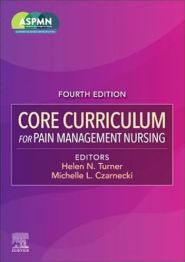Core Curriculum for Pain Management Nursing - E-Book, 4th Edition
Prepare for the nurse’s role in assessing and managing pain! Core Curriculum for Pain Management Nursing, 4th Edition uses an easy-to-read outline format to cover the entire scope of pain management. Written by the American Society of Pain Management Nurses (ASPMN®, the leading nursing organization in pain management), this review begins with foundational concepts and follows with guidelines and tools for effective pain assessment. Coverage of evidence-based pain management strategies and therapies is included for all patient types and ages. Updated to reflect current best practices in nursing, this book provides an excellent review for the ASPMN® pain management certification exam and the RN-BC credentialing exam.
ISBN :
9780323871259
Publication Date :
15-05-2024
Prepare for the nurse’s role in assessing and managing pain! Core Curriculum for Pain Management Nursing, 4th Edition uses an easy-to-read outline format to cover the entire scope of pain management. Written by the American Society of Pain Management Nurses (ASPMN®, the leading nursing organization in pain management), this review begins with foundational concepts and follows with guidelines and tools for effective pain assessment. Coverage of evidence-based pain management strategies and therapies is included for all patient types and ages. Updated to reflect current best practices in nursing, this book provides an excellent review for the ASPMN® pain management certification exam and the RN-BC credentialing exam.
New to this edition
- NEW! Updated content includes the latest changes in clinical practice including pharmacologic and non-pharmacologic pain interventions, integrative and complementary therapies, and the current ANA scope and standards of practice.
- NEW! Revised chapters include Mental Health Disorders and Pain and Managing Pain in the Context of Substance Use Disorder.
- NEW! Cannabis Use in Pain Management chapter is added to this edition.
- NEW! Reorganized content better highlights the complexity of assessment and management of pain.
- NEW two-color design, illustrations, and summary tables are added throughout the book, making difficult concepts easier to understand and remember.
Key Features
- Content written by ASPMN® ensures that information includes the latest in education, research, standards, and practice, as well as a thorough review for the ASPMN® certification exam and the RN-BC credentialing exam..
- Both pharmacologic and non-pharmacologic methods of pain management are described.
- Comprehensive coverage includes adult, pediatric, and geriatric patients along with key subsets of patients such as those who have concomitant addiction, those who have cancer, and those who are under sedation for a procedure.
- Wide-ranging content includes disparities in pain management, the roles of the clinical nurse specialist as well as the nurse practitioner, theories of pain management, the use of research, gender differences in how men and women respond to pain and analgesia, and the effect of depression on pain perception and management.
- Strong nursing focus provides guidelines for the nurse’s role in pain management and in improving the quality of patient care.
- Easy-to-read outline format makes this book a quick and accessible reference.
Author Information
By ASPMN


